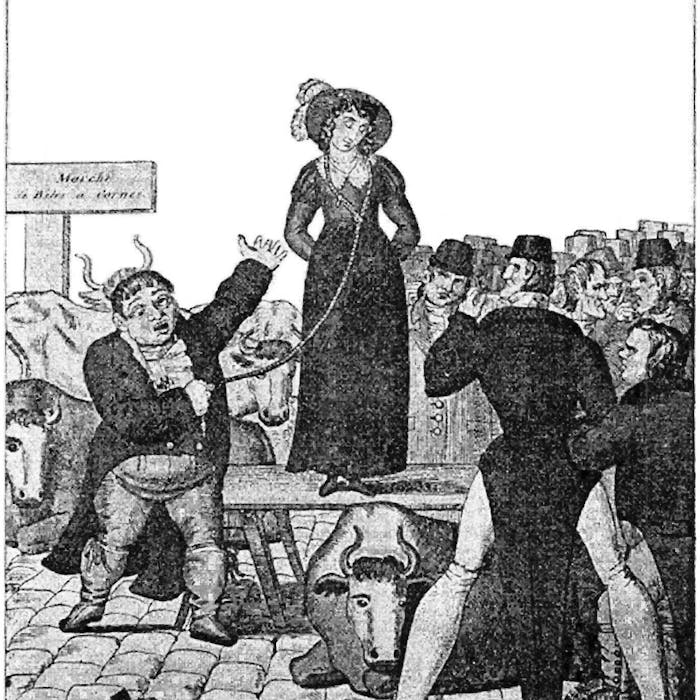
Wife auctions
Anyone who has read Thomas Hardy's novel "The Mayor of Casterbridge" will remember the pivotal early scene where a young labourer, unable to find farm work at an agricultural fair, gets drunk and auctions off his wife and baby. Did the "common folk" really sell their wives like cattle?
Thomas Hardy's novel was published in 1886. While the characters and events in the novel were works of fiction, Hardy was inspired by articles written about wife selling in his local newspaper, The Dorset County Chronicle.
Wife selling was a rare but recognised practice which had occurred for centuries. In this way poor rural people got divorced by mutual consent, particularly before the marriage laws were reformed to make divorce more accessible to ordinary people in 1857. As a mode of popular divorce, it was regarded by the lower-class people who practiced it as a ritual of legitimising the end of a marriage in the eyes of the public, whereas the middle and upper classes viewed it as morally offensive and criminally punishable.
The first recorded case occurred in 1553 but it is thought to be Anglo-Saxon in origin, practiced as early as the eleventh and twelfth century. Wife-selling was not just a method of ‘self-divorce’ but ‘self-marriage’ as the act of selling a wife ended the marriage between the wife and seller-husband and started a marriage between the wife and buyer-husband – although the legitimacy was arguable.
In most reports the sale was announced in advance, perhaps by advertisement in a local newspaper. It usually took the form of an auction, often at a local market, to which the wife would be led by a halter (usually of rope but sometimes of ribbon) around her neck, or arm. Often the purchaser was arranged in advance, and the sale was a form of symbolic separation and remarriage, as in a case from Maidstone, where in January 1815 John Osborne planned to sell his wife at the local market. However, as no market was held that day, the sale took place instead at "the sign of 'The Coal-barge,' in Earl Street", where "in a very regular manner", his wife and child were sold for £1 to a man named William Serjeant. In July the same year a wife was brought to Smithfield market by coach, and sold for 50 guineas and a horse. Once the sale was complete, "the lady, with her new lord and master, mounted a handsome curricle which was in waiting for them, and drove off, seemingly nothing loath to go."
Although the initiative was usually the husband's, the wife had to agree to the sale. An 1824 report from Manchester says that "after several biddings she [the wife] was knocked down for 5s; but not liking the purchaser, she was put up again for 3s and a quart of ale". Frequently the wife was already living with her new partner. In one case in 1804 a London shopkeeper found his wife in bed with a stranger to him, who, following an altercation, offered to purchase the wife. The shopkeeper agreed, and in this instance the sale may have been an acceptable method of resolving the situation.
However, the sale was sometimes spontaneous, and the wife could find herself the subject of bids from total strangers. In March 1766, a carpenter from Southwark sold his wife "in a fit of conjugal indifference at the alehouse". Once sober, the man asked his wife to return, and after she refused he hanged himself. A domestic fight might sometimes precede the sale of a wife, but in most recorded cases the intent was to end a marriage in a way that gave it the legitimacy of a divorce. In some cases the wife arranged for her own sale, and even provided the money for her agent to buy her out of her marriage, such as an 1822 case in Plymouth.
Sales became more common in the mid 18th century, the result of husbands being abroad in the military, navy, or being transported to the colonies. It was commonly believed that an absence of 7 years constituted a divorce, so when the first husband returned to find his wife had a new family, the dilemma was solved by the first husband selling his wife in the market place for a nominal sum.
The most recent case of an English wife sale was reported in 1913, when a woman giving evidence in a Leeds police court during a maintenance case claimed that her husband had sold her to one of his workmates for £1.
Further reading
Links to external websites are not maintained by Bite Sized Britain. They are provided to give users access to additional information. Bite Sized Britain is not responsible for the content of these external websites.
